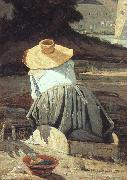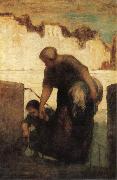Wholesale Oil Painting Reproductions No Minimum and Door to Door! |
|||||||||||
|
|
|||||||||||

|
|||||||||||
|
|
|
||||||||
All Paul-Camille Guigou Oil Paintings |
||||||||
|
|
||||||||
|
|
||||||||
|
Artist Introduction: 1834-1871
French
Paul Camille Guigou Gallery
French painter. Born into a family of landowners, he became a notary's clerk at Apt in 1851 and then in 1854 at Marseille. He learnt to paint with Camp, a teacher at the school in Apt, and then at Marseille with Emile Loubon (1809-63), director of the local Ecole des Beaux-Arts, who urged him (according to Guigou's biographers) to paint directly from nature. Guigou settled in Marseille in 1854, where he participated regularly in the annual Salon of the Societe Artistique des Bouches-du-Rhene. Guigou painted almost exclusively Proven?al landscapes, which were influenced by the works of the Barbizon painters, who exhibited in Marseille, and by the brownish tones and picturesque figures of Loubon's paintings. The Road to Gineste (1859) and The Washerwoman (1860; both Paris, Mus. d'Orsay) reflect the independent tradition of Proveneal painting during the Second Empire, which was characterized by warm colouring and precise lighting used to separate and distinguish forms. His knowledge of the works of Gustave Courbet, acquired during a visit to Paris in 1859, doubtless increased his liking for broad technique and sincere vision, articulated in a strong and ordered construction of space: for example, The Gorges of the Luberon (c. 1861; Amiens, Mus. Picardie). |
||||||||
|
|
||||||||
|
The Washerwoman Painting ID:: 1815 |
1860
Musee d'Orsay, Paris |
|||||||
Height Width |
INS/CM Quality |
|||||||
|
X |
| |||||||
|
|
||||||||
All Honore Daumier Oil Paintings |
||||||||
|
|
||||||||
|
|
||||||||
|
Artist Introduction: French Realist Illustrator, 1808-1879
was a French printmaker, caricaturist, painter, and sculptor, whose many works offer commentary on social and political life in France in the 19th century. A prolific draftsman who produced over 4000 lithographs, he was perhaps best known for his caricatures of political figures and satires on the behavior of his countrymen, although posthumously the value of his painting has also been recognized. Daumier was born in Marseille to Jean-Baptiste Louis Daumier and C??cile Catherine Philippe. His father Jean-Baptiste was a glazier whose literary aspirations led him to move to Paris in 1814, seeking to be published as a poet. In 1816 the young Daumier and his mother followed Jean-Baptiste to Paris. Daumier showed in his youth an irresistible inclination towards the artistic profession, which his father vainly tried to check by placing him first with a huissier, for whom he was employed as an errand boy, and later, with a bookseller. In 1822 he became prot??g?? to Alexandre Lenoir, a friend of Daumier's father who was an artist and archaeologist. The following year Daumier entered the Acad??mie Suisse. He also worked for a lithographer and publisher named Belliard, and made his first attempts at lithography. Having mastered the techniques of lithography, Daumier began his artistic career by producing plates for music publishers, and illustrations for advertisements. |
||||||||
|
|
||||||||
|
|
The Washerwoman Painting ID:: 33883 |
mk87
c.1860
Oil on panel
49x34cm
Paris,Musee Nationa du Louvre
|
||||||
Height Width |
INS/CM Quality |
|||||||
|
X |
| |||||||
|
|
||||||||
All Honore Daumier Oil Paintings |
||||||||
|
|
||||||||
|
|
||||||||
|
Artist Introduction: 1808-1879
French
Honore Daumier Locations
In some 40 years of political and social commentary Honore Daumier created an enormously rich and varied record of Parisian middle-class life in the form of nearly 4,000 lithographs, about 1,000 wood engravings, and several hundred drawings and paintings. In them the comic spirit of Moli??re comes to life once again. After having been the scourge of Louis Philippe and the July Monarchy (1830-1848), Daumier continued as a satirist of Louis Napoleon and the Second Empire (1851-1870). Poor himself, the artist sympathized with the struggling bourgeois and proletarian citizens of Paris. As a man of the left, he battled for the establishment of a republic, which finally came in 1870. Liberals have always applauded Daumier; some conservatives, however, have been inclined to consider him woolly-minded.
Honore Daumier, born on Feb. 26, 1808, in Marseilles, was the son of a glazier. When Honore was 6, the family moved to Paris, where the elder Daumier hoped to win success as a poet. Honore grew up in a home in which humanistic concerns had some importance. A born draftsman and designer who was largely self-taught, he received some formal instruction from Alexandre Lenoir, one of Jacques Louis David students. An obscure artist named Ramelet taught Daumier the elements of the new, inexpensive, and popular technique of lithography. Daumier style is so much his own that it is not easy to disentangle influences from other artists. Rembrandt and Francisco Goya are usually mentioned, along with Peter Paul Rubens, the Venetian school, and photography. |
||||||||
|
|
||||||||
|
|
The Washerwoman Painting ID:: 89111 |
1863(1863)
Medium oil on wood
cyf |
||||||
Height Width |
INS/CM Quality |
|||||||
|
X |
| |||||||
|
|
||||||||
|
Prev Next
|
||||||||
|
|
||||||||
|
Related Paintings to Honore Daumier :. |
||||||||
|
|
||||||||
|
CONTACT US |



